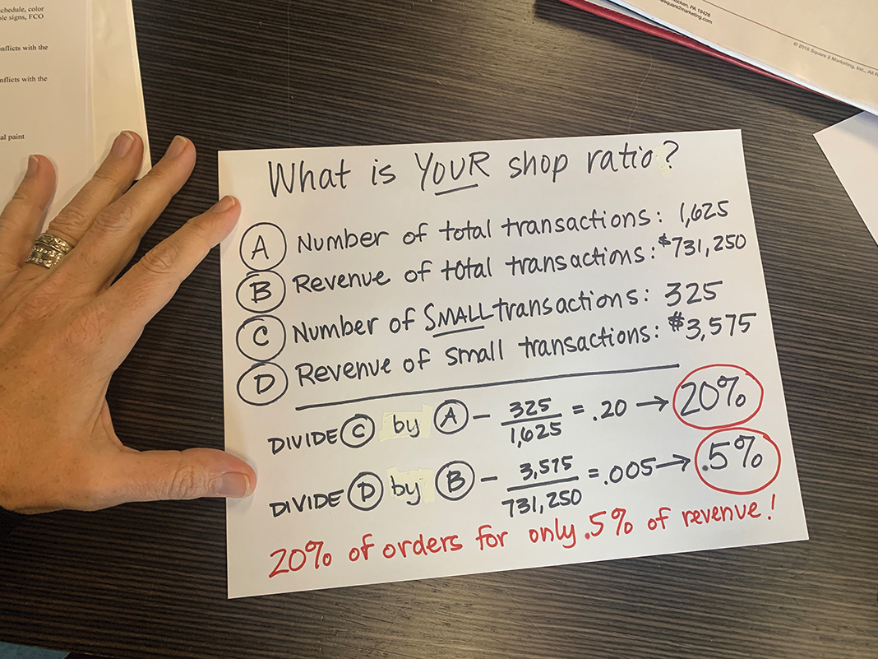EVERY SIGN COMPANY deals with its unique version of the “small order.” For some, this is a single set of channel letters. For others, it might be a single-digit change to an hours of operation window decal. If you’re like most signshop owners, taking care of these low-dollar, low-profit orders seems like the right thing to do for your clients to maintain loyalty and be considered a service-oriented company.
For many shops, the solution for dealing with these small orders is requiring a minimum. This charge — whether $30, $100 or $1,000 — helps cover costs of things beyond material, like design time, sales rep effort and production labor.
I’m not going to try to offer an answer to this for every type of sign company, but I want to provide a way to take a clear-eyed look at these “small orders” and how they may be impacting your team, your bottom line and your operations. If you can see and measure exactly what is happening, you might be more inclined to change how you handle these transactions. Below is a path to seeing these orders more clearly, and next you’ll see solutions that I’ve tried or seen used successfully!
Sample Calculation
- Run a detailed report of your entire year of transactions in Excel. I suggest a report that includes the customers’ names as well as the total for each transaction for the year.
- Sort your Excel report by transaction size, ascending from smallest to largest.
- Calculate a total amount of sales for the year based on those transactions. Let’s use $731,250 for total sales.
- Count the total number of transactions for the year. Let’s use the number 1,625 for the total number of transactions.
- Count the total number of transactions under what you consider “small order” size. Maybe less than $100, or, alternately, if you have a “minimum transaction” count how many are at or under your minimum. Let’s use the number 325 for the small order count.
- Calculate the percent of orders under that “low bar.” You do this by dividing the smaller number by the larger. So if you divide 325 small orders by 1,625 total orders, you end up with 20%.
- Calculate the total dollars in transactions under that “low bar.” Let’s say that total ends up being $3,575.
- Calculate the percentage of low bar sales against total sales. In this case, $3,575 divided by $731,250 is .5%.
Now here’s the sometimes-painful part. Ask yourself, “Is it worth doing (% of transactions) for only ($ in sales)?”
In this example, 20% of the orders generated only a half of a percent of sales!
When I did this exercise in 2021, I discovered that despite having a “minimum” of $90 we had lots of exceptions that creeped through! We did 23% of our transactions at or under that $90, for a whopping $6,000 in sales.
Advertisement
When I could see such a big portion of our transactions represented such a fraction of our business, I redoubled my efforts, raised our minimum to $100 and enforced it more strictly than ever!
Exceptions? Yes, we still make them, but very carefully.
Increase your average transaction, deter less-than-ideal customers and reduce the effort of your team all with one exercise:
- Number of total transactions: 1,625
- Total sales of total transactions: $731,250
- Number of transactions under $101: 325
- Total sales of transactions under $101: $3,575
4 Formulas:
- Divide C into A: Percentage of transactions under $101: 20% (or .20)
- Divide D into B: Percentage of total sales under $101: .5% (or .005)
 Four simple calculations to determine your percent of small orders and their percent of total sales.
Four simple calculations to determine your percent of small orders and their percent of total sales.

 Tip Sheet1 week ago
Tip Sheet1 week ago
 Photo Gallery2 days ago
Photo Gallery2 days ago
 Ask Signs of the Times4 days ago
Ask Signs of the Times4 days ago
 Real Deal1 week ago
Real Deal1 week ago
 Benchmarks6 days ago
Benchmarks6 days ago
 Editor's Note2 weeks ago
Editor's Note2 weeks ago
 Women in Signs1 week ago
Women in Signs1 week ago
 Photo Gallery1 week ago
Photo Gallery1 week ago














